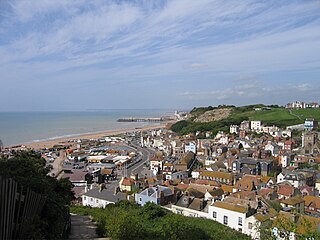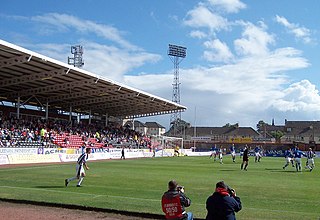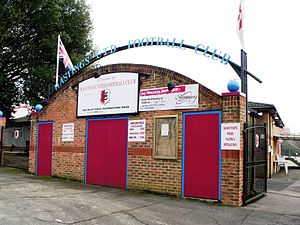
Hastings is a seaside town and borough in East Sussex on the south coast of England, 24 mi (39 km) east of Lewes and 53 mi (85 km) south east of London. The town gives its name to the Battle of Hastings, which took place 8 mi (13 km) to the north-west at Senlac Hill in 1066. It later became one of the medieval Cinque Ports. In the 19th century, it was a popular seaside resort, as the railway allowed tourists and visitors to reach the town. Today, Hastings is a fishing port with the UK's largest beach-based fishing fleet. It has an estimated population of 91,100 as of 2021.

Polegate is a town and civil parish in the Wealden District of East Sussex, England, United Kingdom. It is located five miles (8 km) north of the seaside resort of Eastbourne and is part of the greater area of that town. Although once a railway settlement, its rail links were closed as part of the Beeching cuts. The 2011 census put the civil parish of Polegate at a population of 8,586, with 41.2% aged 65 and over.

Stamford Bridge is a football stadium in Fulham, adjacent to the borough of Chelsea in West London. It is the home of Premier League club Chelsea. With a capacity of 40,343, it is the ninth largest venue of the 2023–24 Premier League season and the eleventh largest football stadium in England.

Holker Street is a sports stadium in Barrow-in-Furness, Cumbria, England. As well as being a football ground, it has also been used for motorcycle speedway. It once had some leisure centre facilities, including four squash courts, which have now been demolished. Its owners, and tenants for the majority of its history, are Barrow A.F.C., who have played at the ground since 1909. Despite its current capacity being just over 6,000, some 16,874 crammed the stadium in 1954 when Barrow played Swansea Town in the FA Cup third round.

Bislett Stadium is a sports stadium in Oslo, Norway. Bislett is Norway's most well known sports arena internationally, with 15 speed skating world records and more than 50 track and field world records having been set here. The original stadium was demolished in 2004 and construction of a new stadium was completed by the summer of 2005. The New Bislett Stadium was designed by C.F. Møller Architects.

The Shay is a multi-purpose sports stadium in Halifax, West Yorkshire, England, home to F.C. Halifax Town football club and Halifax Panthers rugby league team.

St. Leonards F.C. was a semi-professional English football club based in Hastings, East Sussex.

St Mirren Park, more commonly known as Love Street, was a football stadium located on Love Street in Paisley, Scotland. At one time the stadium was capable of accommodating almost 50,000 spectators, however in its final years it had an all-seated capacity of 10,800. Until its closure in 2009, it was the home ground of St Mirren F.C.
Hastings United Football Club was an English football club based in Hastings, East Sussex. They were formed in 1948, playing in the Southern League through to 1985 when they folded due to financial problems.

Horntye Park Sports Complex is a sports and conference centre in Hastings, East Sussex, England. Primarily known as a cricket ground, the venue also contains a large indoor sports hall, an all-weather pitch used for football and hockey and a series of rooms used for meetings, conferences and weddings. The venue is the former home ground of Hastings & St. Leonards Priory Cricket Club and currently home to South Saxons Hockey Club.
The Seedhill Football Ground was a football stadium in Nelson, Lancashire. It was the home of various incarnations of current North West Counties League Division One side Nelson F.C. from 1889, when the Burnley Express reported an opening senior fixture played against Burnley on March 16, 1889, until 1971. During their tenure at Seedhill, Nelson were members of the English Football League between 1921 and 1931. Nelson's last game at Seedhill was a Lancashire Combination fixture on Sunday 28 March 1971 against local rivals, Clitheroe F.C. Local newspaper, the Nelson Leader, reported that a crowd of over a thousand gathered to see Clitheroe beaten by five goals to three in what was not only the last game but also the first Sunday game at the stadium. Nelson then moved to their current Victoria Park ground on Lomeshaye Holme for the start of the 1971–72 season. Seedhill football ground was demolished in the early 1980s to make way for the M65 motorway.

Highbury Stadium is a football stadium in Fleetwood, Lancashire, England, with Wyre Borough Council as the landlords. It is the home ground of Fleetwood Town and was also used for home matches by Blackpool F.C. reserves until 2014. As of the opening of the new Parkside Stand on 16 April 2011, the ground has a capacity of 5,327.
Boghead Park was a football ground in the town of Dumbarton, Scotland. It was owned by Dumbarton F.C., who played there for 121 years between 1879 and 2000. By the time the ground closed in 2000, it was the oldest stadium in Scotland that had been in continuous use.

Bulverhythe, also known as West St Leonards and Bo Peep, is a suburb of Hastings, East Sussex, England with its Esplanade and 15 ft thick sea wall. Bulverhythe is translated as "Burghers' landing place". It used to be under a small headland called Gallows Head, which was washed away by flooding. The suburbs of Filsham, West Marina and Harley Shute are nearby.
Hastings Saxons were a British motorcycle speedway team which operated for two years between 1948 and 1949 at the Pilot Field in Hastings.

Hastings United Football Club, previously known as Hastings Town, is a semi-professional football club based in Hastings, East Sussex. They currently play in the Isthmian League Premier Division and have played their home games at The Pilot Field since 1985, after the demise of the previous Hastings United, whose identity they took on following a name change in 2002.
The Tower Athletic Ground was a sports ground in New Brighton, Merseyside, England. It was the home ground of both New Brighton Tower and New Brighton A.F.C.
The County Ground Stadium, also previously known as the Devon County Athletic Ground, was a rugby union, greyhound racing and speedway stadium in Exeter, Devon.
Hastings & St Leonards United was a professional football club based in Hastings, East Sussex. The club spent four seasons playing in the Southern League, whilst also competing in the South Eastern League and United League.
The South Saxons Open Tournament was an late 19th century and early 20th century combined men's and women's tennis tournament founded in 1880 as the St. Leonards on Sea Lawn Tennis Tournament. The first edition was played on grass courts Archery Gardens, St. Leonards on Sea, Hastings, East Sussex, England. It was the precursor tournament to the later Hastings and St. Leonards Open Lawn Tennis Tournament.
















